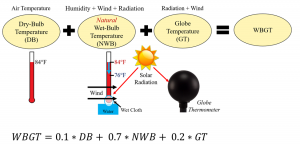What is WBGT?
The Wet-Bulb Globe Temperature (WBGT) is a way to measure the heat stress on a body. WBGT takes into account:
1. temperature
2. humidity
3. wind speed
4. the intensity of the sunlight (i.e. sun angle and degree of cloud cover)
How does WBGT differ from Heat Index?
Like the heat index, the WBGT takes into account the temperature and humidity of the air. It also considers the effects of solar radiation (e.g. heat stress is greater in the sun) and the wind speed (e.g. heat stress much greater when the winds are not blowing).
Wet-Bulb Globe Temperature is used by industrial hygienists, athletes, and the military as a guide to managing workload and level of activity.
Did you know?
In the 1950s, the US military developed the Wet-Bulb Globe Temperature index. In response to a large number of heat illness cases, the military made changes to their existing policy, which used temperature and humidity in a single value (heat index) to evaluate the risk to soldiers working and training in high heat situations. To better represent risk, wind speed, sun angle, and cloud cover were incorporated, forming the Wet-Bulb Globe Temperature. After implementing new policies based on the WBGT measures, there was a drastic reduction in heat illness during basic training.
WBGT has 3 components:
WBGT has three components that incorporate many factors into one measure of risk.
1. dry-bulb temperature
2. natural wet-bulb temperature
3. black globe temperature.
The dry-bulb temperature is also known simply as air temperature.
The natural wet-bulb temperature, is best described as an old-fashioned thermometer, wrapped in a wet cloth. As water evaporates from that wet cloth, evaporation cools the thermometer, which is identical to how the human body cools itself with sweat. Ultimately, the natural-wet bulb temperature incorporates the effect of air temperature, humidity, and solar radiation into one individual temperature.
Lastly, the black globe temperature is the temperature measured by a thermometer placed inside a black globe that is about 6 inches (150 millimeters) in diameter. Solar radiation from the sun heats the outside of the black globe, and the wind blowing across the globe cools the globe, and the thermometer inside measures these changes. In this way, the black globe thermometer reacts in the same way as human skin, including the effects of solar radiation and wind speed on body temperature.
These three temperature components are added together with the NWB given highest weighting:
WBGT = 0.1 * DB + 0.7 * NWB + 0.2 * GT



